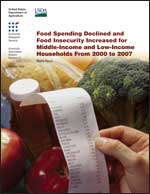Economic Information Bulletin No. (EIB-61) 25 pp
Food Spending Declined and Food Insecurity Increased for Middle-Income and Low-Income Households from 2000 to 2007
From 2000 to 2007, median spending on food by U.S. households declined by 12 percent relative to the (rising) cost of USDA's Thrifty Food Plan, and by 6 percent relative to the (rising) Consumer Price Index (CPI) for Food and Beverages. Over the same period, the national prevalence of very low food security increased by about one-third, from 3.1 percent of households in 2000 to 4.1 percent in 2007. The deterioration in food security was greatest in the second-lowest income quintile, in which the prevalence of very low food security increased by about half. These estimates, based on data from the nationally representative Current Population Survey Food Security Supplement, are corroborated by corresponding declines in food expenditures by middle- and low-income households in the U.S. Bureau of Labor Statistics' Consumer Expenditure Survey. The decline was largest in the second-lowest income quintile, in which average CPI-inflation-adjusted spending for food declined by 16 percent. The declines in food spending by middle- and low-income households were accompanied by increases in spending for housing and, in the two lowest income quintiles, by declines in income and total spending.
Keywords: Food spending, food expenditures, food security, food insecurity, consumer expenditure survey, current population survey food security supplement
In this publication...


